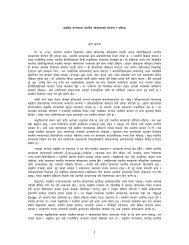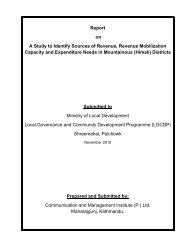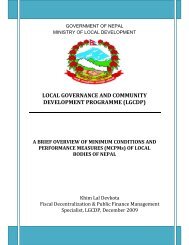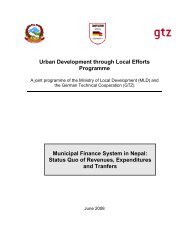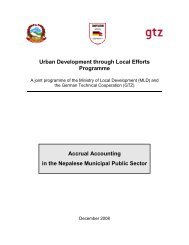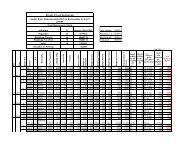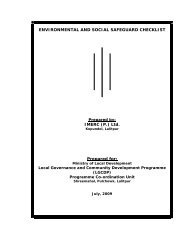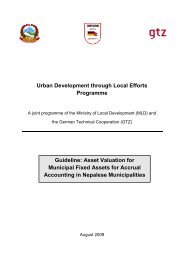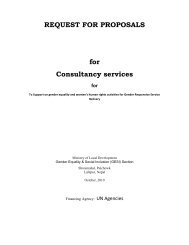<strong>Proposal</strong> <strong>for</strong> a municipal grant allocati<strong>on</strong> <strong>for</strong>mula 8<strong>Proposal</strong> <strong>for</strong> a new local government taxati<strong>on</strong> system in a federal <strong>Nepal</strong>An optimal set of local government taxes should embrace different groups within the local community. These groups should comprise both citizens and businesses. There<strong>for</strong>e, an optimal set of local government taxes results in at least <strong>on</strong>e tax per group targeting• citizens (local income or property related tax) and • businesses (local business tax)This, in c<strong>on</strong>sequence, would require that local government bodies in the c<strong>on</strong>text of <strong>Nepal</strong> have the legal authority to tax• citizens through the integrated property tax, and to tax• businesses through the business tax.Typically, upper levels of government collect income taxes such as pers<strong>on</strong>al income tax or corporate in-come tax. Business taxes and corporate income tax do often tax the same tax base. To avoid double tax-ati<strong>on</strong>, the amount paid by a local business to the local taxing authority (business tax) must be deduct-ible from the corporate income tax payable to upper levels of government. The number of businesses subject to business tax should be larger than the number of businesses subject to corporate income tax. A local business tax should cover all businesses, small-‐scale and even in<strong>for</strong>mal businesses. In prac-tice, this requires an assessment process that can deal with the in<strong>for</strong>mal sector, too. Tax in<strong>for</strong>mati<strong>on</strong> in this case may even provide very helpful in<strong>for</strong>mati<strong>on</strong> <strong>on</strong> the ec<strong>on</strong>omic development of a community. The amount of high-‐yielding local taxes is limited in most countries of the world. Typically, the follow-ing taxes are the most important to local government funding:• pers<strong>on</strong>al income tax (in Nordic countries <strong>on</strong>ly, Denmark, Sweden, Norway)• land tax <strong>on</strong> unbuilt areas• building tax <strong>on</strong> buit-‐up areas, often land tax and building tax are c<strong>on</strong>nected (Anglo-‐Sax<strong>on</strong> property taxati<strong>on</strong>), and • business taxA surtax system <strong>on</strong> the major nati<strong>on</strong>al taxes, such as income tax (n<strong>on</strong>-‐progressive), is widely used to oinance local budgets from internati<strong>on</strong>al perspectives. Local governments can piggyback extra rates <strong>on</strong> the stable nati<strong>on</strong>al taxes using the same tax base. With the development of local taxes, a surtax system can be applied using the existing tax collecti<strong>on</strong> channel of the General Taxati<strong>on</strong> Department, which will reduce administrative costs. A ceiling should be put <strong>on</strong> surcharge rates to limit the wide difference in surcharge rates am<strong>on</strong>g jurisdicti<strong>on</strong>s. The merit of a surtax system lies in guaranteeing stable revenue resources <strong>for</strong> local governments with fewer administrati<strong>on</strong> ef<strong>for</strong>ts. “In the l<strong>on</strong>ger term, a surcharge or piggy-‐back <strong>on</strong> pers<strong>on</strong>al income taxati<strong>on</strong> is the best op-ti<strong>on</strong>. It would allow subnati<strong>on</strong>al governments to set their own tax rates <strong>on</strong> a centrally deoined tax base and within limits set up by the central government” (Ahmad and Brosio 2008).However, piggybacking has some downfalls, too:“While surcharges <strong>on</strong> central tax bases can give a c<strong>on</strong>siderable degree of oiscal aut<strong>on</strong>omy without some of the problems that full aut<strong>on</strong>omy can create, subnati<strong>on</strong>al governments may not agree, if given the choice, that the aut<strong>on</strong>omy thus given is adequate. In particular, Dr Alexander Wegener interpublic c<strong>on</strong>sultancywww.interpublic-‐berlin.de
<strong>Proposal</strong> <strong>for</strong> a municipal grant allocati<strong>on</strong> <strong>for</strong>mula 9<strong>Proposal</strong> <strong>for</strong> a new local government taxati<strong>on</strong> system in a federal <strong>Nepal</strong>they may be c<strong>on</strong>cerned that a government not receiving the revenue from a tax that it ad-ministers is likely to feel less urgency in collecti<strong>on</strong> of or <strong>for</strong> re<strong>for</strong>m of that tax than are those using the revenue to oinance their operati<strong>on</strong>s. They may feel that administrati<strong>on</strong> in practice is inextricably intertwined with tax policy and that, without having choice over administrative decisi<strong>on</strong>s, they lack appropriate oiscal aut<strong>on</strong>omy” (Mikesell 2003).In the c<strong>on</strong>text of <strong>Nepal</strong>, the number of taxpayers <strong>for</strong> high-‐yielding taxes such as individual or corporate income tax, value-‐added tax or others is still low. However, Government might c<strong>on</strong>sider surcharges to increase the overall revenues from these taxes, as there are still a large number of potential taxpayers de facto “exempted” from tax invoices.2.2.2 A reas<strong>on</strong>able sharing of taxes between levels of governmentThe large importance of the LDF to local government funding in <strong>Nepal</strong> (at the moment limited to muni-cipalities) raises the questi<strong>on</strong> which income might replace the LDF when abolished. It is rather evident that given the relatively large number of revenue titles that are assigned to <strong>Nepal</strong>ese municipalities no single additi<strong>on</strong>al “new” tax can be created to replace the high-‐yielding LDF.An alternative and more efoicient way to equip local governments with revenue is to better exploit the shared revenue between central and local governments. We can expect beneoits of tax sharing such as reduced tax competiti<strong>on</strong> am<strong>on</strong>g local governments, ec<strong>on</strong>omies of scale in tax administrati<strong>on</strong> and collecti<strong>on</strong>, and the maintenance of revenue stability over the business cycle etc. However, there are also downsides of the tax sharing scheme, due to disadvantages such as a reducti<strong>on</strong> in local aut<strong>on</strong>omy and the breaking of the link between the beneoits and costs of local public expenditure (Mikesell 2003).This fact is an argument to broaden the tax bases of the current taxes (see the secti<strong>on</strong> above). However, even with a broadening of the tax bases of the current local taxes in <strong>Nepal</strong> – especially the integrated property tax and the business tax as the potentially most important local taxes in the future – there is a need to replace the current grant allocati<strong>on</strong> scheme and the LDF redistributi<strong>on</strong> through a system of shared taxes.Shared taxes are very comm<strong>on</strong> in federal states. In Germany, <strong>for</strong> example, there are a number of taxes which are shared between the federal level and the state level, and there are provisi<strong>on</strong> that guarantee local governments a share. This is the case <strong>for</strong> the distributi<strong>on</strong> of the value-‐added tax, the pers<strong>on</strong>al in-come tax and tax <strong>on</strong> capital gains. Local governments in Switzerland levy supplements to cant<strong>on</strong> individual income taxes (see Mikesell 2003). Each of the twenty-‐six Swiss cant<strong>on</strong>s has its own tax system and local governments are entitled to levy taxes to the extent authorized by the cant<strong>on</strong>. The communal tax is levied as a percentage or multiple of the basic cant<strong>on</strong> tax rate. A federal law requires cant<strong>on</strong>s to harm<strong>on</strong>ize their income tax c<strong>on</strong>cept and deducti<strong>on</strong>s with the federal base, but they may set the amount of deducti<strong>on</strong>s and their rate schedules. Each of the cant<strong>on</strong>s has a separate administrative body <strong>for</strong> collecti<strong>on</strong> of its taxes. The communal tax is piggybacked <strong>on</strong> the cant<strong>on</strong> tax and federal tax is reported <strong>on</strong> the cant<strong>on</strong> return. Thus, the cant<strong>on</strong> is resp<strong>on</strong>sible <strong>for</strong> assessing and collecting federal, cant<strong>on</strong>, and communal income tax – cent-ralizati<strong>on</strong> down from the cant<strong>on</strong> but decentralized administrati<strong>on</strong> up to the federal level. In c<strong>on</strong>trast to the case in many nati<strong>on</strong>s, subnati<strong>on</strong>al – cant<strong>on</strong> and municipal – Swiss governments receive the bulk of income tax collecti<strong>on</strong>s, not the federal government. And, again in c<strong>on</strong>trast to most internati<strong>on</strong>al exper-ience, the income tax is a relatively modest revenue source <strong>for</strong> the federal level. But because the tax is collected across all cant<strong>on</strong>s, it is important that the base and deducti<strong>on</strong>s be standardized in order that Dr Alexander Wegener interpublic c<strong>on</strong>sultancywww.interpublic-‐berlin.de



